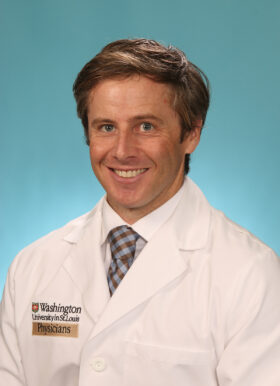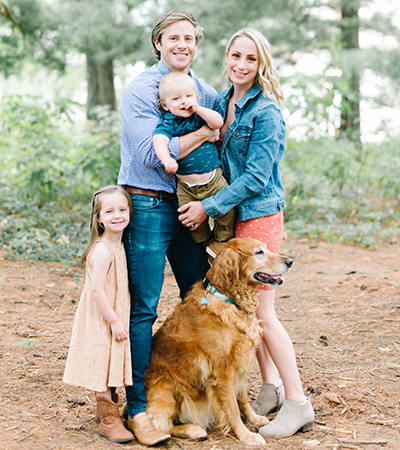Chris Malone, MD

Chris Malone, MD, is an interventional radiologist whose areas of clinical interests include interventional oncology, dialysis access interventions, vascular malformations, embolization for hemorrhage and portal hypertension.
What happened in the course of schooling to influence you to choose your specialty of interventional radiology?
Radiologists are problem-solvers and I was intrigued with the intricacies of imaging. I was drawn towards the physics of imaging modality – especially MRI — how the different stages of disease can have different appearances.
I found radiology to be deeply intellectual and every encounter is deeply rooted in both the science of the disease and the imaging technique you are using. When you are reading a study, you are looking at the science behind the anatomy of the patient and using that information to make a diagnosis.
Why interventional radiology and not diagnostic radiology?
I originally was headed in the direction of diagnostic radiology, but soon discovered I was pretty good with my hands and enjoyed doing procedures that interventional radiologists perform. During internship, I found that even doing routine procedures, like a central line placement, was extremely gratifying. That was my springboard to this specialty.
I was in awe when I saw the impact that interventional procedures can have on a patient. I found the field of interventional radiology to be incredibly innovative. We are constantly looking for new and creative ways to use our minimally invasive tools to deliver the best treatment to our patients.
The collaborative nature of interventional radiology was another big draw for me. There is a lot of camaraderie and support from my peers and mentors. We work closely with other specialties – especially surgery, hepatology and oncology. We help each other – I like that sense of community.
What is the difference between diagnostic radiology and interventional radiology?
Diagnostic radiology has a large armamentarium (resources to aid in the diagnosis and treatment of medical conditions) of imaging methods whether its CT, MRI, ultrasound, or X-ray to make imaging diagnoses noninvasively. This also involves developing and protocoling specific scans to fit the diagnostic needs for each patient. Interventional radiology uses these imaging techniques to do procedures in a minimally invasive fashion (usually through a pinhole in the skin or through a blood vessel). These procedures have a treatment intent but can often provide further imaging detail or diagnosis in a focused fashion. Both work hand in hand and we rely on what diagnostic radiology is telling us and vice versa.
When a patient comes to me, he or she has already been diagnosed by one of our skilled diagnostic colleagues at Mallinckrodt Institute of Radiology (MIR). Patients are usually referred from other physicians and we also have patients that refer themselves for various procedures and conditions such as uterine fibroid embolization. My job is to determine the best treatment for that patient. For example, if a patient has been diagnosed with a liver tumor by one of our diagnostic radiologists and needs a tumor ablation (destroying a tumor using heat)—I use the CT scanner to guide the needle into the tumor to perform that ablation.
Later, after the procedure, the patient will have diagnostic scans to see how the tumor responded to the treatment. We care for our patients at all stages of their treatment – before, during and after the procedure.

What brought you to Washington University?
This was an opportunity I couldn’t turn down. As one of the top medical schools in the country, Washington University is a great place to launch an academic career. There are so many amazing resources here in terms of research and clinical practice. Everything is in place for a physician and researcher to succeed.
The reputation of Mallinckrodt Institute of Radiology (MIR) is one of the most well-renown in the world. Many of the individuals in my section are very well known nationally and internationally including Dan Picus, MD, Mike Darcy, MD, and Suresh Vendantham, MD and have served as great mentors.
Which aspect of your practice is most interesting?
What is interesting about my practice is that not one day is the same as another. The procedures can vary from venous access (to administer intravenous therapy or to provide an access point for treatments) to life-saving embolization for hemorrhage control (as a result of trauma or gastrointestinal bleeding).
My practice specifically deals with treating liver tumors, treating vascular malformations and working with dialysis patients.
For patients with liver tumors, I work closely with transplant surgeons and will treat a patient if he or she is not eligible for surgery. We can also treat the tumor with the intent that they will be bridged or downstaged to where they are eligible for a resection or liver transplant surgery in the future.
For dialysis patients, I work with the surgeon to identify and treat any dysfunction the patient has with hemodialysis fistulas or grafts.
I find this cooperative relationship with the other specialists very gratifying.
Another rewarding aspect of my practice is our vascular anomaly clinic at St. Louis Children’s Hospital which focuses on treating vascular malformations. I’ll work with dermatologists, hematologists, geneticists, head and neck surgeons, plastic surgeons. It is an incredibly rewarding experience because we learn a lot from each other as we put our heads together to come up with the best treatment plan for our patient.
What is a vascular malformation?
They are basically abnormal growths or collections of blood vessels. They can be composed of veins, lymphatics, or be abnormal connections between arteries and veins called arteriovenous malformations. Most often a patient is born with them or the growths can become noticeable early in life as they grow with the patient, and that is why we often treat them as children. The vascular malformations can be visible on the outside or inside of the body. They can also be associated with other diseases and other syndromes.
It is important to have other people on board that can provide expertise for the vascular malformation – either medication or surgery.
What new developments in your field are you most excited about?
I’m excited that by using minimally invasive techniques we can access almost anywhere in the body. I can guide a catheter through an artery that is feeding a liver tumor and can treat it by delivering a drug or radiation. This is called embolization.
In the future, there will be new ways to deliver drug or therapies to tumors and other disease processes.
As a result of emerging immunotherapies, we are gaining a better understanding of the body’s immune system response to treatment for liver cancer. I find that to be very exciting.
Finally, there is a change in the training for interventional radiology – a medical student can now match (or choose) this specialty as his or her residency right after medical school. The previous path to interventional radiology had been through diagnostic radiology. This meant that after you completed your residency training in diagnostic radiology, you continued your training with a fellowship in interventional radiology.
I think this new residency specialty will increase the exposure to interventional radiology for younger medical students and we will see more students choose it as a specialty.
Where are you from?
I’m originally from Maryland, outside Washington, DC — but I haven’t lived there for a very long time. I’ve lived all over the country – New Orleans, Dallas, Hawaii, San Diego, Seattle.
Living in so many places has exposed me to a lot of different people – with different ways of thinking, different attitudes and different ways of doing things. It’s been to my benefit and I found it to be very gratifying.
Which particular award or achievement is most gratifying?
I’ve been lucky to have had great mentors throughout medical school, residency, fellowship and now here.
My residency was in a specialized tract where we were trained to become clinician scientists, so we did an extra year of research. I found that to be very productive and rewarding. The mentors I had for that, not just my research mentor, but other people in that research community in San Diego, had a big impact on me.
During my Fellowship training, it was most gratifying to train under Dr. Karim Valji, who is the section chief of interventional radiology at the University of Washington. He has been one of the most amazing individuals I’ve ever met. He taught me how to think about every patient and every procedure in a critical way.
What’s the best advice you’ve received?
The best advice I’ve received is to surround yourself with people that are better than you and smarter than you. Doing this helps you grow off their wisdom and makes you better because you can learn from their insight and mistakes.
If you weren’t a doctor, what would you like to be doing?
I would like to be a chef. I really enjoy cooking and find it to be an enjoyable release.